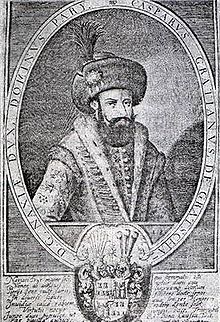| Gaspar Graziani | |
|---|---|
 | |
| Prince of Moldavia | |
| Reign | February 1619 – September 1620 |
| Predecessor | Radu Mihnea |
| Successor | Alexandru VII Iliaș |
| Born | c. 1575/1580 |
| Died | 29 September 1620 (aged around 40–45) Țuțora |
| Religion | Orthodox |
Gaspar (or Gașpar, Gasparo) Graziani (also credited as Grazziani, Gratiani and Grațiani; 1575/1580 – 29 September 1620) was Voivode (Prince) of Moldavia between February 4OS/February 14 NS 1619 and September 19 OS/September 29 NS 1620 (see Adoption of the Gregorian calendar).
Early life
Gaspar Graziani de Candia is of Venetian Italian or Croatian origin and is assumed that he originate from Bihać area. The byname "Croatian" used along with his Christian name and surname, Croat Gašpar Graziani Kandija, appears in European and Ottoman sources.
A polyglot born in Dalmatia, Graziani had been in the service of several European powers: he was an interpreter for the English diplomatic mission in the Ottoman Empire, and then an envoy of both the Grand Duke of Tuscany Cosimo II and the Spanish Viceroy of Naples to the Porte, negotiating the release of Christian sailors captured by Barbary pirates.
The sultan awarded Graziani the title of Duke of Paros and Naxos in 1616; he became a close ally of the Doges and, like his predecessor and rival Radu Mihnea, a self-declared admirer of the Serenissime system of government; Graziani also married into a family of Venetian patricians.
In Moldavia
Appointed Dragoman, he was charged by the Turks with missions in the Holy Roman Empire, and nevertheless acted as a spy in favour of the Habsburgs. These activities, along with bribery and promises of absolute loyalty to the Porte, gathered Graziani the support he needed in his bid for the Moldavian throne. In order to qualify for the customary requirements, he quickly converted from Roman Catholicism to Eastern Orthodoxy and accepted the sacraments. On his way to Moldavia, he was received in Adrianople by a delegation of 20 boyars, and is said to have been acclaimed by thousands upon his arrival on the shores of the Danube.
He organized an armed guard of 500 for his personal defence, and defied the Ottomans by starting negotiations for an alliance with Poland's King Sigismund III Vasa. The Sultan ordered him removed and a kapucu was sent for this purpose; Graziani had the envoy and his 300-strong retinue massacred. He managed to contribute with a minuscule number of his troops to hetman Stanisław Koniecpolski's effort and was present at the Battle of Cecora, but, as he was making his way to refuge in Poland, he was murdered in the village of Braniște (nowadays in Rîșcani, Republic of Moldova) by two of his boyars, Șeptilici and Goia, who were fearful of Ottoman reprisals.
His life was the subject of Ioan Slavici's 1888 tragedy, Gaspar Gratiani.
See also
References
| This article includes a list of references, related reading, or external links, but its sources remain unclear because it lacks inline citations. Please help improve this article by introducing more precise citations. (September 2016) (Learn how and when to remove this message) |
- "Italianul Gaspar Graziani își face un rost în viață pe tronul Moldovei, dar puterea îi pierde repede capul" [The Italian Gaspar Graziani makes his fortune on the throne of Moldavia, but power soon makes him lose his head] (in Romanian). Cătălin Pena for Evenimentul istoric. 27 June 2020.
- Manea-Grgin, Castilia (2006). "Neobičan knez na moldavskom prijestolju: Hrvat Gašpar Graziani (1619.-1620.)" [An unusual prince on the Moldavian throne: Croat Gašpar Graziani (1619-1620)]. Povijesni prilozi - Historical Contributions (in Croatian). 25 (30). Zagreb: Croatian Institute of History: 51–77. Retrieved 21 April 2024.
U ovom radu se, po prvi put u hrvatskoj historiografiji, analiziraju život i vladavina moldavskoga kneza hrvatskog podrijetla Gašpara Grazianija.
[For the first time in Croatian historiography, this paper analyzes the life and rule of the Moldavian prince of Croatian origin, Gaspar Graziani] In the present paper, the author deals with published data on the historical figure, Gašpar Graziani (1570/80?-1620), almost unknown in Croatian historiography. He was probably from the region of Bihać, although his real family name is not known. His name, along with the word "Croatian", can be commonly found in contemporary European and Ottoman sources.
External links
- Cristian Luca, Influssi occidentali sull’atteggiamento politico di alcuni principi dei Paesi Romeni nei secoli XVI e XVII
- Cognome Graziani
- L'origine del cognome Graziani
| Preceded byRadu Mihnea | Prince/Voivode of Moldavia 1619–1620 |
Succeeded byAlexandru Iliaș |